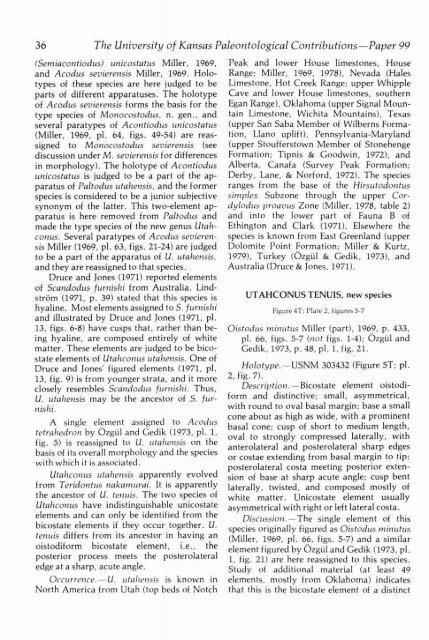View - KU ScholarWorks - University of Kansas
View - KU ScholarWorks - University of Kansas
View - KU ScholarWorks - University of Kansas
Create successful ePaper yourself
Turn your PDF publications into a flip-book with our unique Google optimized e-Paper software.
36 The <strong>University</strong> <strong>of</strong> <strong>Kansas</strong> Paleontological Contributions—Paper 99<br />
(Semiacontiodus) unicostatus Miller, 1969,<br />
and Acodus sevierensis Miller, 1969. Holotypes<br />
<strong>of</strong> these species are here judged to be<br />
parts <strong>of</strong> different apparatuses. The holotype<br />
<strong>of</strong> Acodus sevierensis forms the basis for the<br />
type species <strong>of</strong> Monocostodus, n. gen., and<br />
several paratypes <strong>of</strong> Acontiodus unicostatus<br />
(Miller, 1969, pl. 64, figs. 49-54) are reassigned<br />
to Monocostodus sevierensis (see<br />
discussion under M. sevierensis for differences<br />
in morphology). The holotype <strong>of</strong> Acontiodus<br />
unicostatus is judged to be a part <strong>of</strong> the apparatus<br />
<strong>of</strong> Paltodus utahensis, and the former<br />
species is considered to be a junior subjective<br />
synonym <strong>of</strong> the latter. This two-element apparatus<br />
is here removed from Paltodus and<br />
made the type species <strong>of</strong> the new genus Utahconus.<br />
Several paratypes <strong>of</strong> Acodus sevierensis<br />
Miller (1969, pl. 63, figs. 21-24) are judged<br />
to be a part <strong>of</strong> the apparatus <strong>of</strong> U. utahensis,<br />
and they are reassigned to that species.<br />
Druce and Jones (1971) reported elements<br />
<strong>of</strong> Scandodus furnishi from Australia. Lindstrom<br />
(1971, p. 39) stated that this species is<br />
hyaline. Most elements assigned to S. furnishi<br />
and illustrated by Druce and Jones (1971, pl.<br />
13, figs. 6-8) have cusps that, rather than being<br />
hyaline, are composed entirely <strong>of</strong> white<br />
matter. These elements are judged to be bicostate<br />
elements <strong>of</strong> Utahconus utahensis. One <strong>of</strong><br />
Druce and Jones' figured elements (1971, pl.<br />
13, fig. 9) is from younger strata, and it more<br />
closely resembles Scandodus furnis hi. Thus,<br />
U. utahensis may be the ancestor <strong>of</strong> S. furishi.<br />
A single element assigned to Acodus<br />
tetrahedron by Ozgül and Gedik (1973, pl. 1,<br />
fig. 5) is reassigned to U. utahensis on the<br />
basis <strong>of</strong> its overall morphology and the species<br />
with which it is associated.<br />
Utahconus utahensis apparently evolved<br />
from Teridontus nakamurai. It is apparently<br />
the ancestor <strong>of</strong> U. tennis. The two species <strong>of</strong><br />
Utahconus have indistinguishable unicostate<br />
elements and can only be identified from the<br />
bicostate elements if they occur together. U.<br />
tennis differs from its ancestor in having an<br />
oistodiform bicostate element, i.e., the<br />
posterior process meets the posterolateral<br />
edge at a sharp, acute angle.<br />
Occurrence. — U. utahensis is known in<br />
North America from Utah (top beds <strong>of</strong> Notch<br />
Peak and lower House limestones, House<br />
Range; Miller, 1969, 1978), Nevada (Hales<br />
Limestone, Hot Creek Range; upper Whipple<br />
Cave and lower House limestones, southern<br />
Egan Range), Oklahoma (upper Signal Mountain<br />
Limestone, Wichita Mountains), Texas<br />
(upper San Saba Member <strong>of</strong> Wilberns Formation,<br />
Llano uplift), Pennsylvania-Maryland<br />
(upper Stoufferstown Member <strong>of</strong> Stonehenge<br />
Formation; Tipnis & Goodwin, 1972), and<br />
Alberta, Canafa (Survey Peak Formation;<br />
Derby, Lane, & Norford, 1972). The species<br />
ranges from the base <strong>of</strong> the Hirsutodontus<br />
simplex Subzone through the upper Cordylodus<br />
proavus Zone (Miller, 1978, table 2)<br />
and into the lower part <strong>of</strong> Fauna B <strong>of</strong><br />
Ethington and Clark (1971). Elsewhere the<br />
species is known from East Greenland (upper<br />
Dolomite Point Formation; Miller & Kurtz,<br />
1979), Turkey (OzgUl & Gedik, 1973), and<br />
Australia (Druce & Jones, 1971).<br />
UTAHCONUS TENUIS, new species<br />
Figure 4T; Plate 2, figures 5-7<br />
Oistodus minutus Miller (part), 1969, p. 433,<br />
pl. 66, figs. 5-7 (not figs. 1-4); OzgUl and<br />
Gedik, 1973, p. 48, pl. 1, fig. 21.<br />
Holotype. —USNM 303432 (Figure 5T; pl.<br />
2, fig. 7).<br />
Description. — Bicostate element oistodiform<br />
and distinctive; small, asymmetrical,<br />
with round to oval basal margin; base a small<br />
cone about as high as wide, with a prominent<br />
basal cone; cusp <strong>of</strong> short to medium length,<br />
oval to strongly compressed laterally, with<br />
anterolateral and posterolateral sharp edges<br />
or costae extending from basal margin to tip;<br />
posterolateral costa meeting posterior extension<br />
<strong>of</strong> base at sharp acute angle; cusp bent<br />
laterally, twisted, and composed mostly <strong>of</strong><br />
white matter. Unicostate element usually<br />
asymmetrical with right or left lateral costa.<br />
Discussion. —The single element <strong>of</strong> this<br />
species originally figured as Oistodus mintitus<br />
(Miller, 1969, pl. 66, figs. 5-7) and a similar<br />
element figured by OzgUl and Gedik (1973, pl.<br />
1, fig. 21) are here reassigned to this species.<br />
Study <strong>of</strong> additional material (at least 49<br />
elements, mostly from Oklahoma) indicates<br />
that this is the bicostate element <strong>of</strong> a distinct
















